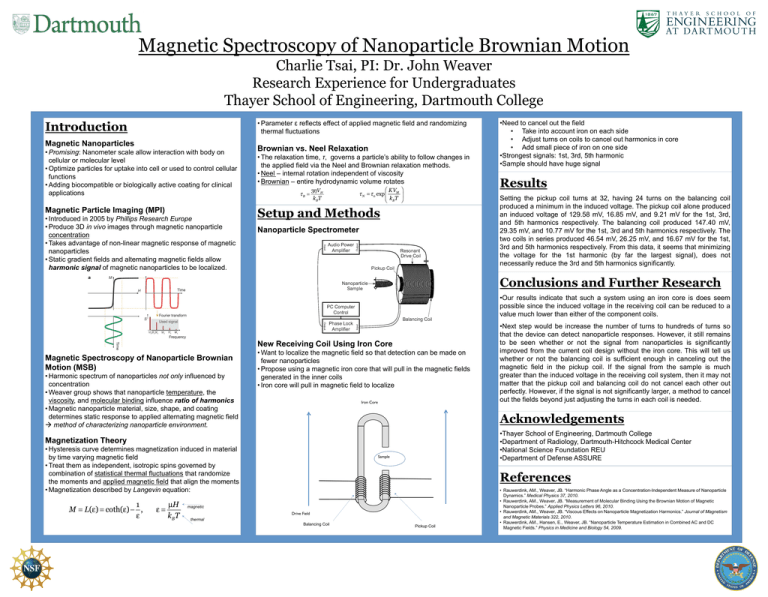Poster - Thayer School of Engineering at Dartmouth
advertisement

Magnetic Spectroscopy of Nanoparticle Brownian Motion Charlie Tsai, PI: Dr. John Weaver Research Experience for Undergraduates Thayer School of Engineering, Dartmouth College •Parameter reflects effect of applied magnetic field and randomizing thermal fluctuations Introduction Magnetic Nanoparticles •Promising: Nanometer scale allow interaction with body on cellular or molecular level •Optimize particles for uptake into cell or used to control cellular functions •Adding biocompatible or biologically active coating for clinical applications Magnetic Particle Imaging (MPI) •Introduced in 2005 by Phillips Research Europe •Produce 3D in vivo images through magnetic nanoparticle concentration •Takes advantage of non-linear magnetic response of magnetic nanoparticles •Static gradient fields and alternating magnetic fields allow harmonic signal of magnetic nanoparticles to be localized. Brownian vs. Neel Relaxation •The relaxation time, , governs a particle’s ability to follow changes in the applied field via the Neel and Brownian relaxation methods. •Neel – internal rotation independent of viscosity •Brownian – entire hydrodynamic volume rotates •Need to cancel out the field • Take into account iron on each side • Adjust turns on coils to cancel out harmonics in core • Add small piece of iron on one side •Strongest signals: 1st, 3rd, 5th harmonic •Sample should have huge signal Results Setting the pickup coil turns at 32, having 24 turns on the balancing coil produced a minimum in the induced voltage. The pickup coil alone produced an induced voltage of 129.58 mV, 16.85 mV, and 9.21 mV for the 1st, 3rd, and 5th harmonics respectively. The balancing coil produced 147.40 mV, 29.35 mV, and 10.77 mV for the 1st, 3rd and 5th harmonics respectively. The two coils in series produced 46.54 mV, 26.25 mV, and 16.67 mV for the 1st, 3rd and 5th harmonics respectively. From this data, it seems that minimizing the voltage for the 1st harmonic (by far the largest signal), does not necessarily reduce the 3rd and 5th harmonics significantly. Setup and Methods Nanoparticle Spectrometer Conclusions and Further Research •Our results indicate that such a system using an iron core is does seem possible since the induced voltage in the receiving coil can be reduced to a value much lower than either of the component coils. New Receiving Coil Using Iron Core Magnetic Spectroscopy of Nanoparticle Brownian Motion (MSB) •Harmonic spectrum of nanoparticles not only influenced by concentration •Weaver group shows that nanoparticle temperature, the viscosity, and molecular binding influence ratio of harmonics •Magnetic nanoparticle material, size, shape, and coating determines static response to applied alternating magnetic field method of characterizing nanoparticle environment. •Want to localize the magnetic field so that detection can be made on fewer nanoparticles •Propose using a magnetic iron core that will pull in the magnetic fields generated in the inner coils •Iron core will pull in magnetic field to localize Iron Core •Next step would be increase the number of turns to hundreds of turns so that the device can detect nanoparticle responses. However, it still remains to be seen whether or not the signal from nanoparticles is significantly improved from the current coil design without the iron core. This will tell us whether or not the balancing coil is sufficient enough in canceling out the magnetic field in the pickup coil. If the signal from the sample is much greater than the induced voltage in the receiving coil system, then it may not matter that the pickup coil and balancing coil do not cancel each other out perfectly. However, if the signal is not significantly larger, a method to cancel out the fields beyond just adjusting the turns in each coil is needed. Acknowledgements •Thayer School of Engineering, Dartmouth College •Department of Radiology, Dartmouth-Hitchcock Medical Center •National Science Foundation REU •Department of Defense ASSURE Magnetization Theory •Hysteresis curve determines magnetization induced in material by time varying magnetic field •Treat them as independent, isotropic spins governed by combination of statistical thermal fluctuations that randomize the moments and applied magnetic field that align the moments •Magnetization described by Langevin equation: Sample References magnetic Drive Field thermal Balancing Coil Pickup Coil • Rauwerdink, AM., Weaver, JB. “Harmonic Phase Angle as a Concentration-Independent Measure of Nanoparticle Dynamics.” Medical Physics 37, 2010. • Rauwerdink, AM., Weaver, JB. “Measurement of Molecular Binding Using the Brownian Motion of Magnetic Nanoparticle Probes.” Applied Physics Letters 96, 2010. • Rauwerdink, AM., Weaver, JB. “Viscous Effects on Nanoparticle Magnetization Harmonics.” Journal of Magnetism and Magnetic Materials 322, 2010. • Rauwerdink, AM., Hansen, E., Weaver, JB. “Nanoparticle Temperature Estimation in Combined AC and DC Magnetic Fields.” Physics in Medicine and Biology 54, 2009.



